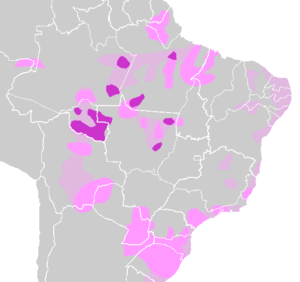Tupi–Guarani languages
| Tupi–Guarani | |
|---|---|
| Geographic distribution | Argentina, Brazil, Bolivia, French Guiana, Paraguay, Peru |
| Linguistic classification | Tupian
|
| Subdivisions | |
| Glottolog | tupi1276 |
 Tupi–Guarani (medium pink), other Tupian (violet), and probable range c. 1500 (pink-grey) | |
Tupi–Guarani () is the name of the most widely distributed subfamily of the Tupian languages of South America. It includes fifty languages, including the best-known languages of the family, Guarani and Old Tupi.
The words petunia, jaguar, piranha, ipecac, tapioca, jacaranda, anhinga, carioca, and capoeira are of Tupi–Guarani origin.[citation needed]
Classification
Rodrigues & Cabral (2012)
Rodrigues & Cabral (2012) propose eight branches of Tupí–Guaraní:
- Guaraní (Group I)
- Guarayu (Group II): Guarayu, Pauserna,** Sirionó (dialects Yuqui, Jorá**)
- Tupí (Group III): Old Tupi (lingua franca dialect Tupí Austral), Tupinambá (dialects Nheengatu, AKA Língua Geral as lingua franca, and Potiguára), Cocama–Omagua*, Tupinikin**
- Tenetehara (Group IV): Akwáwa (dialects Asuriní, Suruí do Pará, Parakanã), Avá-Canoeiro, Tapirapé, Tenetehára (dialects Guajajara, Tembé), Turiwára
- Kawahib (Group VI): Apiacá, Kawahíb (numerous varieties; incl. Piripkúra, Diagói?), Kayabí, Karipúna, ?Uru-Pa-In
- Kamayurá (Group VII)
- Xingu (Group VIIIa): Anambé (of Cairarí), Amanayé, Xingú Asuriní, Araweté, Aurá, Ararandewara
- Northern (Group VIIIb): Anambé of Ehrenreich, Emerillon, Guajá, Wayampi, Zo'é, Takunyapé, Urubú–Kaapor, Wayampipukú
*Cabral argues that Kokama/Omagua is a mixed language, and so not directly classifiable, though most of its basic vocabulary is Tupi–Guarani.
**Not listed in Rodrigues & Cabral
Karipuna language (Amapá) may be spurious.
Michael, et al. (2015)
Michael, et al. (2015) propose the following classification for the Tupi-Guarani languages.
- Tupí-Guaraní
- Kamaiurá
- Nuclear Tupí-Guaraní
- (branch)
- Central
- (branch)
- (branch)
- Peripheral
O'Hagan (2014)[1] proposes that Proto-Tupi-Guarani was spoken in the region of the lower Tocantins and Xingu Rivers. Proto-Omagua-Kokama then expanded up the Amazon River, Proto-Tupinamba expanded south along the Atlantic coast, and the Southern branch expanded up along the Tocantins/Araguaia River towards the Parana River basin.
See also
- Tupí people (Tupinambá)
- Guaraní people
- Urubú–Kaapor Sign Language
References
- ^ O'Hagan, Zachary (with Keith Bartolomei, Natalia Chousou-Polydouri, Emily Clem, Erin Donnelly and Lev Michael). 2014. A Computational-phylogenetic Classification of Tupí-Guaraní and its Geographical Spread. Language Variation and Change, October 20, Chicago.
- Michael, Lev, Natalia Chousou-Polydouri, Keith Bartolomei, Erin Donnelly, Vivian Wauters, Sérgio Meira, Zachary O'Hagan. 2015. A Bayesian Phylogenetic Classification of Tupí-Guaraní. LIAMES 15(2):193-221.
External links
- Swadesh lists of Tupi–Guarani basic vocabulary words (from Wiktionary's Swadesh-list appendix)
